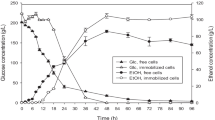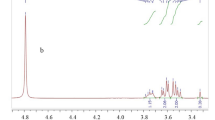Abstract
Bacterial cellulose produced from soybean oil refinery effluent is a good immobilization carrier because of the large pores in its fiber network, its high water-holding capacity, and its good biocompatibility. In this study, it was applied to immobilization of oleaginous yeasts for treating soybean oil refinery effluent. The immobilization percentage reached 50%, and the removal of chemical oxygen demand and oil content reached 92.1% and 93.1%, respectively, during dynamic immobilization using a mass percentage of bacterial cellulose of 30% and an immobilization time of 24 h, which were significantly higher than those of free oleaginous yeasts or yeasts immobilized by bacterial cellulose from rich medium. The immobilized oleaginous yeasts facilitated the recovery of the yeasts and effectively treated three batches of soybean oil refinery effluent. The immobilized oleaginous yeasts recovered after soybean oil refinery effluent treatment were pyrolyzed to produce bio-oil, which contributed to more alkanes and a higher calorific value of bio-oil in the pyrolysis products as compared to those of free oleaginous yeasts. As bacterial cellulose used as an oleaginous yeast cell carrier is produced from soybean oil refinery effluent, no waste of immobilization materials is involved and an efficient waste-into-oil bioprocess is developed.





Similar content being viewed by others
Availability of data and materials
All data generated or analyzed during this study are included in this published article.
References
Dourou M, Kancelista A, Juszczyk P, Sarris D, Bellou S, Triantaphyllidou IE, Rywinska A, Papanikolaou S, Aggelis G (2016) Bioconversion of olive mill wastewater into high-added value products. J Clean Prod 139:957–969. https://doi.org/10.1016/j.jclepro.2016.08.133
Frazão CJR, Silva NHC, Freire CSR, Silvestre AJD, Xavier AMRB, Tavares APM (2014) Bacterial cellulose as carrier for immobilization of laccase: optimization and characterization. Eng Life Sci 14(5):500–508
Huang C, Guo HJ, Xiong L, Wang B, Shi SL, Chen XF, Lin XQ, Wang C, Luo J, Chen XD (2016) Using wastewater after lipid fermentation as substrate for bacterial cellulose production by Gluconacetobacter xylinus. Carbohydr Polym 136:198–202. https://doi.org/10.1016/j.carbpol.2015.09.043
Imran A, Bramer EA, Seshan K, Brem G (2016) Catalytic flash pyrolysis of biomass using different types of zeolite and online vapor fractionation. Energies 9(3):187. https://doi.org/10.3390/en9030187
Jung HI, Lee OM, Jeong JH, Jeon YD, Park KH, Kim HS, An WG, Son HJ (2010) Influence of glycerol on production and structural–physical properties of cellulose from Acetobacter sp. V6 cultured in shake flasks. Bioresour Technol 101(10):3602–3608
Kim HJ, Jin JN, Kan E, Kim KJ, Lee SH (2017) Bacterial cellulose−chitosan composite hydrogel beads for enzyme immobilization. Biotechnol Bioproc E 22(1):89–94
Kirdponpattara S, Phisalaphong M (2013) Bacterial cellulose–alginate composite sponge as a yeast cell carrier for ethanol production. Biochem Eng J 77:103–109. https://doi.org/10.1016/j.bej.2013.05.005
Liang HW, Guan QF, Zhu Z, Song LT, Yao HB, Lei X, Yu SH (2012) Highly conductive and stretchable conductors fabricated from bacterial cellulose. NPG Asia Mater 4(6):e19–e19
Ling J, Tian Y, Toledo RAD, Shim H (2017) Cost reduction for the lipid production from distillery and domestic mixed wastewater by Rhodosporidium toruloides via the reutilization of spent seed culture medium. Energy 136:135–141. https://doi.org/10.1016/j.energy.2016.04.008
Muradov N, Taha M, Miranda AF, Wrede D, Kadali K, Gujar A, Stevenson T, Ball AS, Mouradov A (2015) Fungal-assisted algal flocculation: application in wastewater treatment and biofuel production. Biotechnol Biofuels 8:24. https://doi.org/10.1186/s13068-015-0210-6
Nguyen DN, Ton NMN, Le VVM (2009) Optimization of Saccharomyces cerevisiae immobilization in bacterial cellulose by ‘adsorption−incubation’ method. Int Food Res J 16:59–64
Qiao N, Fan X, Zhang XZ, Shi YF, Wang L, Yu DY (2019) Soybean oil refinery effluent treatment and its utilization for bacterial cellulose production by Gluconacetobacter xylinus. Food Hydrocoll 97:105185. https://doi.org/10.1016/j.foodhyd.2019.105185
Qiao N, Gao MX, Zhang XZ, Du YD, Fan X, Wang L, Liu N, Yu DY (2019) Trichosporon fermentans biomass flocculation from soybean oil refinery wastewater using bioflocculant produced from Paecilomyces sp. M2–1. Appl Microbiol Biotechnol 103:2821–2831. https://doi.org/10.1007/s00253-019-09643-z
Rajkumar K, Muthukumar M, Sivakumar R (2010) Novel approach for the treatment and recycle of wastewater from soya edible oil refinery industry—an economic perspective. Resour Conserv Recycl 54(10):752–758
Sarris D, Stoforos NG, Mallouchos A, Kookos IK, Koutinas AA, Aggelis G, Papanikolaou S (2017) Production of added-value metabolites by Yarrowia lipolytica growing in olive mill wastewater-based media under aseptic and non-aseptic conditions. Eng Life Sci 17(6):695–709
Sharma DMS, Sharma DA, Verma DS, Dodiya HS (2014) Treatment of edible oil refinery waste water by using chemical and biological process. Int J Eng Sci Res Technol 3(9):115–120
Shen Q, Lin H, Wang Q, Fan XP, Yang YY, Zhao YH (2015) Sweetpotato vines hydrolysate promotes single cell oils production of Trichosporon fermentans in high-density molasses fermentation. Bioresour Technol 176:249–256. https://doi.org/10.1016/j.biortech.2014.11.045
Shi YF, Ren HM, Yu DY (2018) Research progress on treatment of wastewater by airlift loop Reactor. J Northeast Electr Power Univ 38(4):76–84
Shi YF, Wu S, Ren HM, Jin MT, Wang L, Qiao N, Yu DY (2020) Computational fluid dynamics and factor analysis of a novel swirling demulsified airlift loop reactor for the treatment of refined soybean oil wastewater. Bioresour Technol 296:122316. https://doi.org/10.1016/j.biortech.2019.122316
Ton NMN, Le VVM (2011) Application of immobilized yeast in bacterial cellulose to the repeated batch fermentation in wine-making. Int Food Res J 18(3):983–987
Wang LP, Schütz C, Salazar-Alvarez G, Titirici MM (2014) Carbon aerogels from bacterial nanocellulose as anodes for lithium ion batteries. RSC Adv 4(34):17549. https://doi.org/10.1039/c3ra47853j
Yang XY, Wang X, Zhao BW, Li Y (2014) Simulation model of pyrolysis biofuel yield based on algal components and pyrolysis kinetics. Bioenergy Res 7(4):1293–1304
Yao WY, Wu X, Zhu J, Sun B, Zhang YY, Miller C (2011) Bacterial cellulose membrane—a new support carrier for yeast immobilization for ethanol fermentation. Process Biochem 46(10):2054–2058
Yin N, Santos TMA, Auer GK, Crooks JA, Oliver PM, Weibel DB (2014) Bacterial cellulose as a substrate for microbial cell culture. Appl Environ Microb 80(6):1926–1932
Yu DY, Hu S, Liu WS, Wang XN, Jiang HF, Dong NH (2020) Pyrolysis of oleaginous yeast biomass from wastewater treatment:kinetics analysis and biocrude characterization. Renew Energy 150:831–839. https://doi.org/10.1016/j.renene.2020.01.028
Yu DY, Hu S, Wang L, Chen QC, Dong NH (2020) Comparative study on pyrolysis characteristics andkinetics of oleaginous yeast and algae. Int J Hydrogen Energy 45:10979–10990. https://doi.org/10.1016/j.ijhydene.2020.02.052
Yu DY, Wang XN, Fan X, Ren HM, Hu S, Wang L, Shi YF, Liu N, Qiao N (2018) Refined soybean oil wastewater treatment and its utilization for lipid production by the oleaginous yeast Trichosporon fermentans. Biotechnol Biofuels 11:299. https://doi.org/10.1186/s13068-018-1306-6
Yu DY, Yang MY, Gao B, Liu WC (2011) Disposal of domestic sewage by heterotrophic nitrification−aerobic denitrifier bacteria immobilized with bacterial cellulose membrane. Fresen Environ Bull 20(2):398–404
Yu N, Xing DF, Li W, Yang Y, Li Z, Li YR, Ren NQ (2017) Electricity and methane production from soybean edible oil refinery wastewater using microbial electrochemical systems. Int J Hydrogen Energy 42(1):96–102
Zhao HW, Xia J, Wang JM, Yan XF, Wang C, Lei TZ, Xian M, Zhang HB (2018) Production of bacterial cellulose using polysaccharide fermentation wastewater as inexpensive nutrient sources. Biotechnol Biotechnol Equip 32(2):350–356
Żywicka A, Peitler D, Rakoczy R, Junka AF, Fijałkowski K (2016) Wet and dry forms of bacterial cellulose synthetized by different strains of Gluconacetobacter xylinus as carriers for yeast immobilization. Appl Biochem Biotechnol 180(4):805–816
Żywicka A, Wenelska K, Junka A, Czajkowska J, Fijałkowski K (2019) An efficient method of Yarrowia lipolytica immobilization using oil- and emulsion-modified bacterial cellulose carriers. Electron J Biotechnol 41:30–36. https://doi.org/10.1016/j.ejbt.2019.06.002
Żywicka A, Wenelska K, Junka A, Chodaczek G, Szymczyk P, Fijałkowski K (2019) Immobilization pattern of morphologically different microorganisms on bacterial cellulose membranes. World J Microbiol Biotechnol 35:11. https://doi.org/10.1007/s11274-018-2584-7
Funding
This work was supported by grants from the National Natural Science Foundation of China (31470787, 21708003) and Department of Science and Technology of Jilin Province (20190902014TC, 20170519015JH).
Author information
Authors and Affiliations
Corresponding authors
Ethics declarations
Conflict of interest
The authors declare that they have no conflict of interest.
Additional information
Publisher's Note
Springer Nature remains neutral with regard to jurisdictional claims in published maps and institutional affiliations.
Rights and permissions
About this article
Cite this article
Qiao, N., Fan, X., Hu, S. et al. Bacterial cellulose as an oleaginous yeast cell carrier for soybean oil refinery effluent treatment and pyrolysis oil production. Bioprocess Biosyst Eng 44, 661–671 (2021). https://doi.org/10.1007/s00449-020-02476-5
Received:
Accepted:
Published:
Issue Date:
DOI: https://doi.org/10.1007/s00449-020-02476-5




